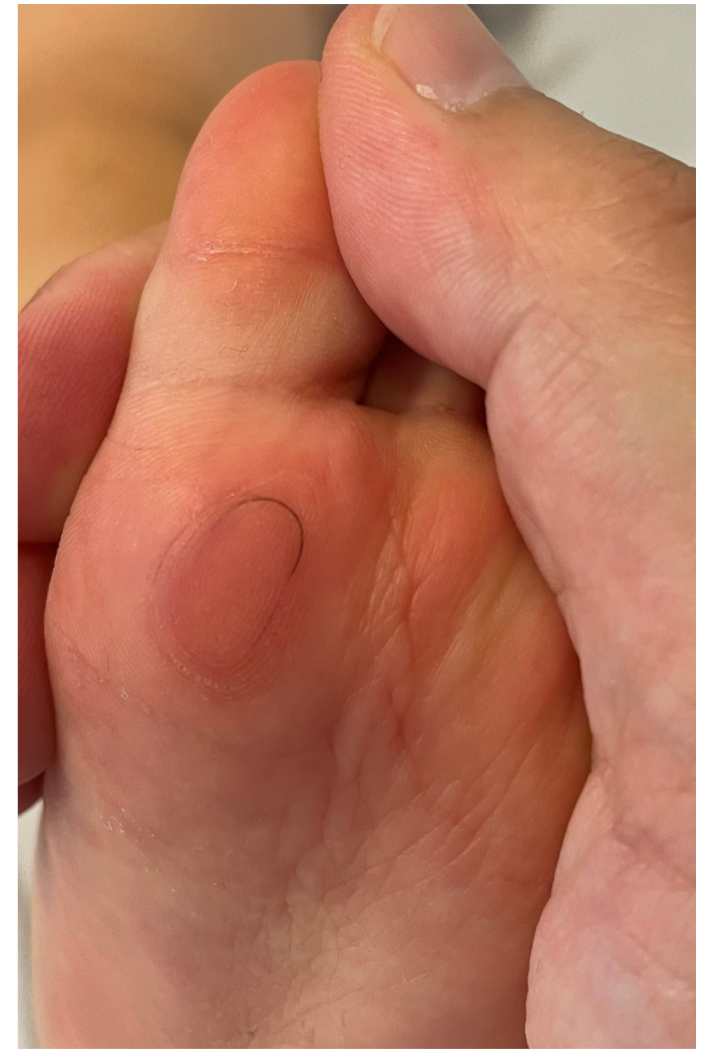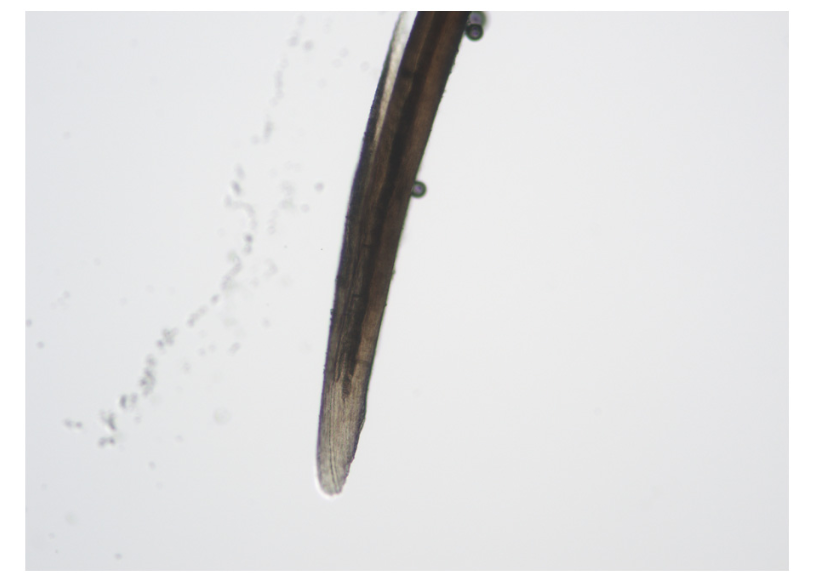Creeping Hair: A Nice Case of Cutaneous Pili Migrans in a 19 month Old Girl
Moving Hair in the Skin: A Case of Cutaneous Pili MIgrans
Cutaneous pili migrans is a rare skin condition characterized by a fragment of hair embedded in the epidermis or dermis layers of the skin. It can change position over time - raising concern about a possible diagnosis of cataneous larva migrans (an infectious syndrome due to infection by hookworms).
Bruschi L et al 2022
Authors present a case of a 19 month old girl was referred for a suspicion of cutaneous larva migrans. Her parents had noticed that a lesion was present on the sole of her left foot and that it had changed position. The lesion appeared soon after the girl had played on the play on the lawn in a public park. It was not painful and it was not itchy. It did not prevent the child from walking. The child had not travelled outside of Switzerland where the family was from.
Position of wire like object on day it was noticed. From Bruschi L et al. Did You Ever See a Creeping Hair? J Pediatr. 2022 Dec 17;S0022-3476(22)01127-1. used with creative commons license.
Examination showed that a black semicircular wire-like lesion was visible at the border of a slightly erythematous round patch at the base of her left great toe It was noted that the lesion was on in a very different location in photographs taken 5 days earlier.
Position of wire like object 5 days after it was noticed. From Bruschi L et al. Did You Ever See a Creeping Hair? J Pediatr. 2022 Dec 17;S0022-3476(22)01127-1. used with creative commons license.
The wire was grasped after repeated scratching of the superficial layers of the epidermis. The authors then visualized, under the microscope, a naked hair shaft of about 2 cm, with a sharp and triangular end and without a hair follicle. This confirmed the diagnosis of cutaneous pilus migrans.
Microscopic appearance of wire confirming that it is a hair. From Bruschi L et al. Did You Ever See a Creeping Hair? J Pediatr. 2022 Dec 17;S0022-3476(22)01127-1. used with creative commons license.
Discussion and Comment
Cutaneous pili migrans is a rare skin condition characterized by a fragment of hair embedded in the epidermis or dermis layers of the skin. Differential diagnosis includes cutaneous larva migrans – as well as calluses and warts (when it occurs on the soles of the feet)
Cutaneous pili migrans (CPMs) was first reported by Yaffee in 1957 and, to date, there have been about 40-50 cases reported. Most patients are from Asia. This patient was from Switzerland (although we are not provided with any information about the racial background per se).
Body locations in CPM involved include the toe, sole, ankle, breast, cheek, neck and abdomen. They can be asymptomatic or painful.
Pediatric patients have been reported in about a dozen cases of CPM. The youngest patient is 6 months (Xie et al 2012) Most CPM occur on the sole in children – although lesions on the leg, scalp and back have been reported.
Most lesions are unilateral although a 2010 report by Kim et al reported a bilateral case involving the soles .
CPM has been described under various names including buried hair, bristle migrans, burrowing hair, migrating hair and creeping hair, creeping eruption.
Why does CPM occur?
The big question is why does this occur? The etiology of CPM is not fully known. It has been assumed to be the result of a sharp hair tip penetrating the skin. Wet skin may be a facilitating factor and help the hair get into the skin but walking or body motion are proposed to help activate the movement of the hair within the skin. Hair cuts or walking without shoes may predispose some patients.
Racial background could be a relevant factor - at least in some patients. It is interesting the most cases are reported in East Asian counties. It has been noted that Asian hair has high tensile strength and the largest cross-sectional area compared with that of all other ethnic groups. Whether this has a role is not clear.
Treatment of CPM
Removal of the black hair shaft heals the lesion completely
How can one differentiate cutaneous pili migrans from cutaneous larva migrans?
Cutaneous pili migrans tends to move in a linear fashion in only one direction. In contrast, cutaneous larva migrans can move in any direction and generally results in more serpinginous or tortuous tracts. Furthermore, lesions in cutaneous larva migrans are extremely itchy, whereas those in cutaneous pili migrans may be either asymptomatic or painful.
REFERENCES
Laura Bruschi et al. Did You Ever See a Creeping Hair? J Pediatr. 2022 Dec 17;S0022-3476(22)01127-1.
Kim YH et al. Cutaneous pili migrans. Ann Dermatol. 2014 Aug;26(4):534-5.
Xie H, Zhang RZ, Zhu WY. A new site of cutaneous pili migrans in a 6-month-old infant. Indian J Dermatol Venereol Leprol 2012;78:498-9.
Li B, Ma L, ZhouYB. Cutaneous pilus migrans on the back of a 6-year-old boy. J Eur Acad Dermatol Venereol 2022;36:e727-9.
Kim JY, Silverman RA. Migrating hair: a case confused with cutaneous larva migrans. Pediatr Dermatol 2010;27:628-30.
This article was written by Dr. Jeff Donovan, a Canadian and US board certified dermatologist specializing exclusively in hair loss.




